Liatris (gayfeather, blazing star, button snakeroot, colic root) is a unique flower producing pinkish-purple blooms. That beautiful plant is highly friendly to the environment since it attracts a significant number of insects, including bees, bumblebees, and butterflies. There are about thirty species of this perennial that originated in prairies throughout America. Almost half of them grow as garden plants.
Native Americans used this flower to cure limb pain and backache and as an excellent diuretic and heart medicine. Nowadays, leaves and roots of this plant are widely used for treating sore throats, kidney disease, and even gonorrhea. If you want to grow a plant entirely resistant to pests, Liatris is the flower of choice. Just be careful. Although it is not a toxic plant, you should avoid using it as a food for your rabbit or guinea pig. It seems that its leaves may cause digestive problems.
Why You Should Grow Liatris
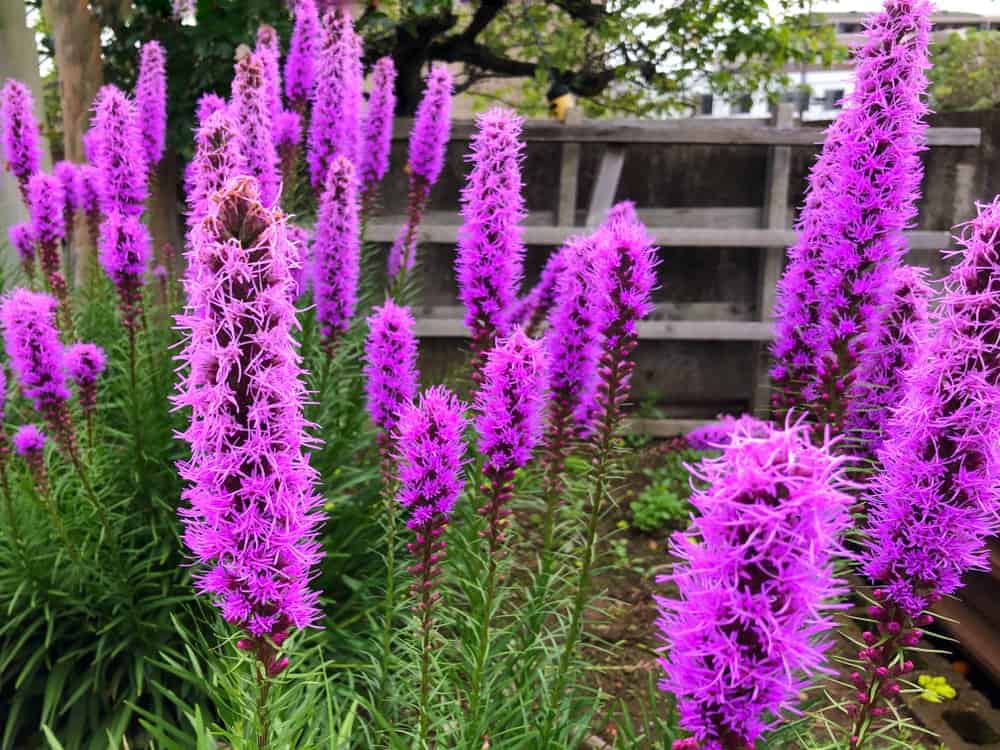
1. Liatris is functional and beautiful
You can expect to get a hardy, 2 to 5 feet (61 cm – 1.5 m) tall, attractive plant with flower heads full of tiny blooms from early summer to late autumn. As a tall and colorful flower, Liatris is the right choice for a backdrop to shorter species. Also, you can grow this flower as a fence or border.
2. Liatris has an interesting way of flowering
I am impressed by its unusual way of blooming. It starts at the top of the stem and goes downward. When you want to use them for floral arrangements, you should cut off the top one-third of the flower spike containing open buds. Unopened buds below will start blooming almost immediately.
3. Liatris is a fauna friendly plant
Liatris attracts bees and butterflies, which pollinate flowers in your garden throughout the growing season. After the blooming period, their seeds will become food for birds.
4. Liatris uses space efficiently
Even though Liatris is a quite tall flower, it will take surprisingly little space. That makes this flower an excellent plant to fill even the smallest empty parts in your yard.
5. Liatris is an easily adaptable plant
Since Liatris quickly accommodates to the different garden conditions, you can grow it regardless of the environmental factors in the region where you live.
6. Liatris is an easy-to-grow flower
As long as you provide full sun and the well-drained ground for your Liatris, it will thrive and beautify your garden. Even the low fertile soil won’t be an issue, but lack of the sun will affect blooming.
7. Liatris is a drought-tolerant plant
The great advantage of Liatris is that its corms retain water. Therefore, this plant doesn’t require too much watering throughout the summer.
8. Liatris is a pest-resistant plant
It seems that this flower is highly resistant to most pests and diseases other gardening plants suffer from.
The Most Popular Varieties of Liatris

Among forty known species of Liatris occurring in nature, gardeners usually grow three types:
- Spicata
- Aspera
- Pycostachya
Within these species, there are a few desirable cultivars. The most popular of them belong to Liatris spicata (Dense Blazing Star) including:
- Floristan Violett – That deep violet flower is often a part of professional flower arrangements.
- Callilepsis – With long and strong stems, this variety is an excellent choice for cut flowers.
- Alba – If you prefer dwarf versions, this dazzling, 1.5 feet (46 cm) tall white plant is perfect for you.
- Kobold – Even though it looks tiny, it produces fantastic purple flowers. That makes this variety an ideal choice for a low border in your garden.
- Snow Queen – It is my favorite variety with beautiful and unique white blooms.
Lesser-known types of Liatris in the US |
|||
|
Type |
Flower | Height | Region |
| Southern blazing star (Liatris squarrulosa) | Purplish-red | 6 feet (1.8 m) |
Midwestern and southern states |
|
Rough gayfeather (Liatris aspera) |
Purple | 5 feet (1.5 m) | Midwestern, eastern, and southern states |
| Pinkscale blazing star (Liatris elegans) | Lilac, with white inner petals | 4 feet (1.2 m) |
Texas, South Carolina, Oklahoma, and Florida |
|
Meadow blazing star (Liatris ligulistylis) |
Pinkish purple | 4 feet (1.2 m) | Colorado, Wisconsin, and New Mexico |
| Grass leafed blazing star (Liatris graminifolia) | White to pale lavender | 2 feet (61 cm) |
New Jersey and Alabama |
|
Earl’s blazing star (Liatris squarrosa) |
Violet-red | 2 feet (61 cm) |
Colorado, Texas, Virginia, and Florida |
How to Plant Liatris in Your Garden
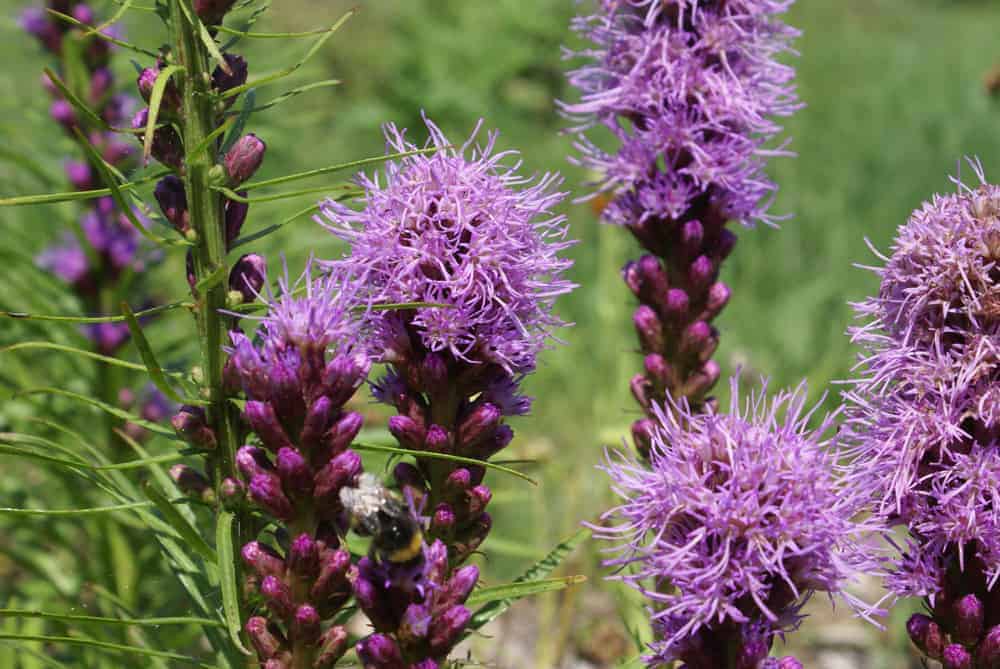
Liatris Propagating by corms
Start splitting corms in fall. Purchase a high-quality garden knife and dig corms up after they freeze for the first time in the current year. Pick up small corms clinging to the main one, and keep them in a cold place until spring. Then you can re-plant healthy corms.
Find a sunny spot in your garden appropriate for Liatris, and make 5 to 6 inches (13 – 15 cm) deep hole for each flower. If you want to plant more corms, place them approximately 14 to 16 inches (35.5 – 40.5 cm) apart.
Take care to put the corm’s bottom downwards to allow the correct development of roots. If you make a mistake and place them upside down, the plant won’t grow.
Fill the hole with the gardening soil and press it down firmly to remove air pockets. Cover the ground with 1 inch (2.5 cm) thick layer of mulch and water regularly. The best option is to water with a watering can as soon as the soil dries out.
Liatris Propagation by seeds
Unless you have already had your own Liatris in the garden, buying seeds is a cheaper way of getting this beautiful flower than purchasing corms. Be prepared that it is a bit longer process, and you will need to wait for a while to see the first flowers.
The best time for sowing is in May. Find certificated seeds in a local nursery or garden center. You can space them in a garden flat or put one seed per a section of an egg carton. Cover them with 0.25 inches (6 mm) of the garden soil.
Depending on the variety, your seeds will need from 20 to 60 days to germinate. After the seedlings reach 1 inch (2.5 cm) high, you should transplant them in the garden. Put them about 2 inches (5 cm) deep into the ground after the last frost passes.
There is one more possibility. You can sow seeds directly in the garden from October to the middle of November. The procedure is the same, and you should take care to finish the job before the low temperatures harden the soil.
Liatris Propagation by softwood cutting
It is not a usual way of propagating Liatris, but you can cut softwood cuttings in spring. There is not any particular procedure for their planting. Pick out healthy stems, prepare them on the ordinary way, and plant directly into the garden.
How to Care Liatris in Your Garden
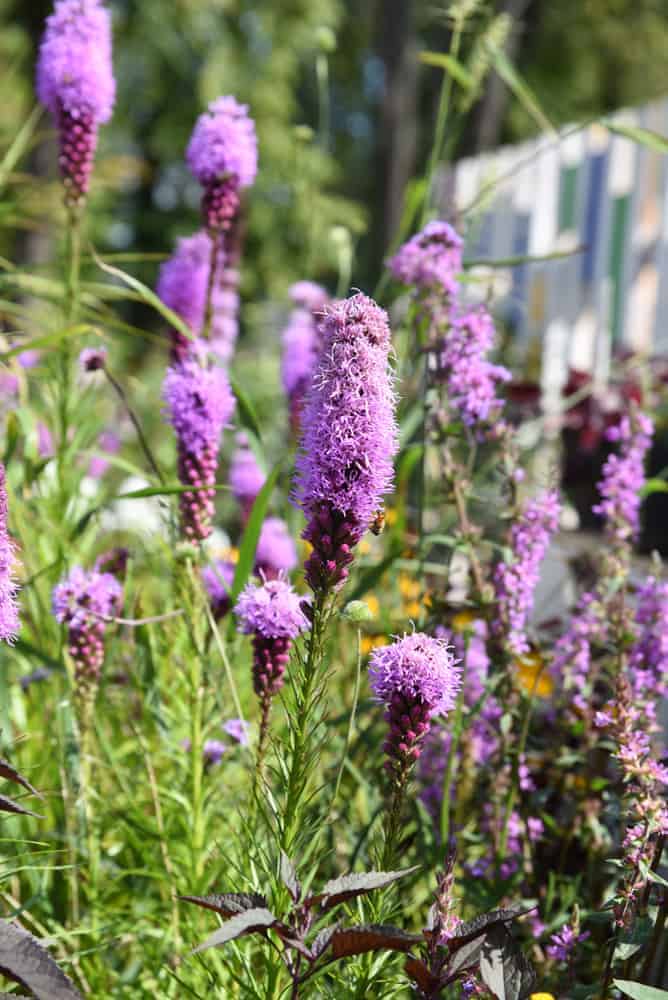
Space
Whether you are planting a bunch of Liatrises or mix them with other species, you should provide at least 15 inches (38 cm) of space between them.
Soil
Liatris can grow in different types of soil, but it prefers fertile, slightly acid, and well-draining ones. This plant can’t thrive in the too soggy ground, and it is better providing enough necessary nutrients for it.
If the soil in your garden is alkaline, you can correct it by adding coffee grounds around your flower. Also, if you live in a windy area, you should find a way to protect your plant from the wind.
Light
This perennial requires full sun, and you should grow it in the part of your garden with at least six to eight hours of sun a day. Some species can tolerate shade and can thrive even in sheltered places.
Temperatures
This plant tolerates every seasonal variation in temperatures. That means that you don’t need to protect it from rain, warmth, or coldness.
Watering
Liatris is a drought-tolerant plant and does well without much water. Water it regularly during the first year after planting, and that would be it. The mature plant can live with water that gets through rain and snow.
Fertilizing
Plant this flower in a substrate with some compost, horn meal, or lime. After that, your Liatris will need light fertilization in spring. The best solution is to apply compost, commercial flower fertilizer, or compost tea.
Keep in mind that you should stop with feeding in August to let your flower to prepare for winter appropriately.
Mulching
Liatris won’t tolerate waterlogging, but it needs a certain level of soil moisture. So, place a thin layer of mulch around the stems, and it will be enough to keep the ground moist, weed-free, and warm. Choose leaves or grass clippings as mulch to make your plant happy.
Pruning and deadheading
You can extend the blooming season of your plant by deadheading wilted flowers. At the same time, that action will prevent seed-sowing and keep your garden clean and tidy. Use pruning scissors and cut fade blooms to basal leaves.
On the other hand, you can leave wilted flowers to turn to seeds at the end of the season. That seeds will be an excellent food source for birds in winter. Cut the plant to the ground once it stops creating seeds. That is the way to prepare your Liatris for winter.
Don’t forget to clean cuttings after deadheading to avoid the development of fungi. Left around, they may also become a shelter for slugs and snails.
Liatris Pests and Diseases
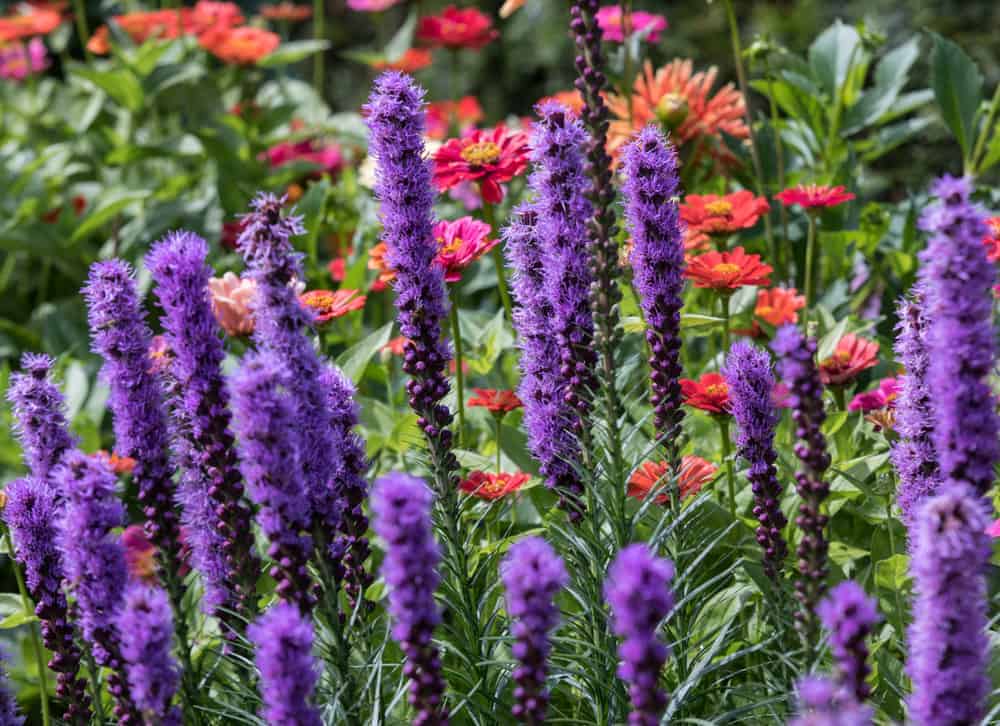
Liatris is not particularly prone to pests and diseases. However, it may have some problems if you plant it in an inadequate place with the unsuitable soil.
For example, you may notice the leggy or shrink plants with deformed flowers if they grow in the shade. On the other hand, the appearance of discolored spots on the stems and leaves can be the result of the growth in the barren land.
Root rot
If you grow Liatris in the soggy soil, you will probably face root rotting. Consequently, your flower will start wilting and become greasy. Carefully remove rotten parts and transplant your Liatris in a dry and well-drained substrate.
Stem rot
When you see the occurrence of yellow lower leaves after which the plant begins to wilt, you will know that you are dealing with fungi.
In that case, unlike the other fungal diseases, a white mycelium grows around the crown of the plant. Destroy all infected parts of the flower and remove the topsoil around it.
Leaf spots
You may notice some necrotic spots on the foliage caused by different pathogens. Try to solve the problem with an excellent fungicide as soon as you see the first symptoms.
Rust
These parasites may cause disease on your Liatris. You will notice gelatinous horns on stems and the foliage surrounded by yellow and discolored changes. Destroy fungi with an adequate fungicide.
Powdery mildew
These fungi grow on the leaves, and you will find white spores and vegetative mycelium on the underside of the leaves. The first thing you should do is to prevent dispersion of mildew spores and infestation of other plants. Kill fungi with a quality fungicide.
Verticillium wilt
These fungi impair water flow throughout the plant. As a result, one side of your flower may wilt, and you will get Liatris with twisted and yellow leaves. Symptoms look like those following the drought, even though the level of moisture of the soil is adequate. Get rid of infected plants and the topsoil as well.
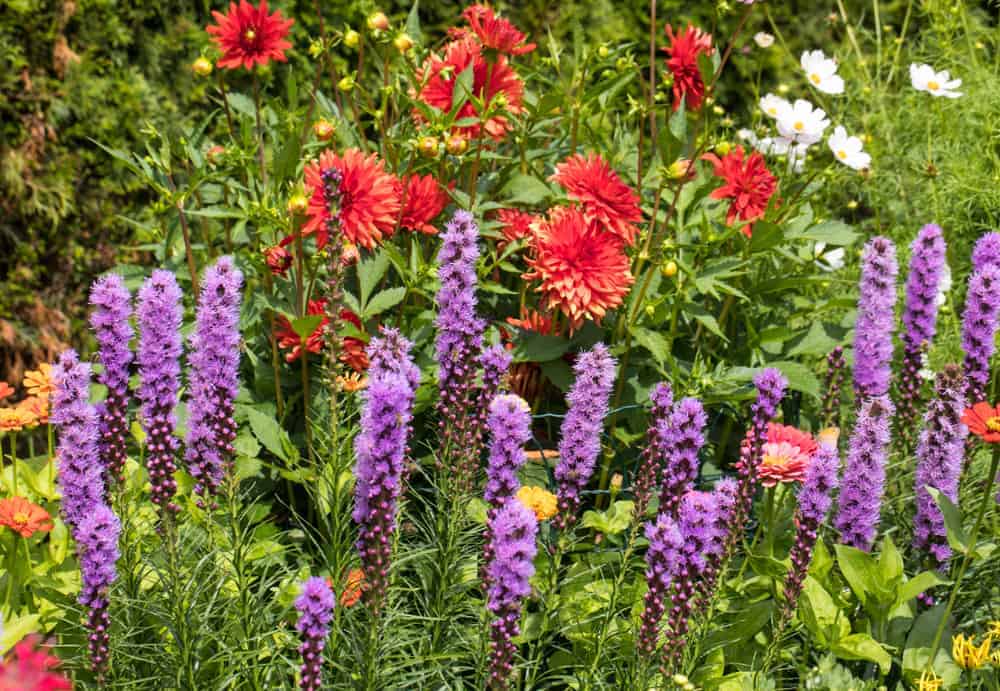
Leave a comment